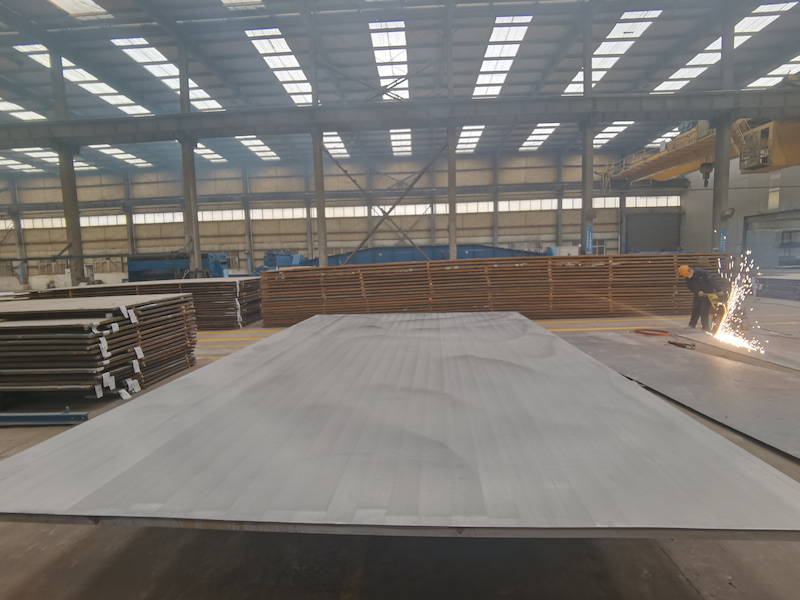Nickel (Ni) and nickel-based alloy steel clad plate C276 is a composite material consisting of a layer of nickel or a nickel alloy laminated to a layer of steel. The matrix steel is usually carbon steel, low alloy steel or stainless steel. The material combines the strength and durability of steel with the corrosion resistance and ductility of nickel.
The manufacturing process for nickel and nickel-based alloy steel clad plates usually involves either explosion welding or hot rolling techniques. In explosion welding, the nickel and steel layers are placed together and subjected to a high-energy explosion, which fuses them.
Base Material :
Carbon steelClad Material :
Nickel and Nickel-base alloyBase Thickness :
from 8mm to 400mmClad Thickness :
from 2mm to 16mmClad Plate Total Width :
up to 4200mmClad Plate Total Length :
up to 14300mm
Nickel and Nickel-base Alloy Steel Clad Plate
are used in various industries, including marine, oil and gas, salt production, chemical processing, and nuclear power. These plates are commonly used to construct tanks, pipelines, and other equipment that require corrosion resistance and durability.
Corrosion Resistance: nickel and nickel-base alloy steel clad plates are highly resistant to corrosion, making them ideal for harsh environments.
High Strength: They use a combination of nickel and nickel-base alloy steel clad plates, which provides excellent strength. This makes them ideal for heavy-duty applications.
Cost-effective: Compared to pure nickel products, nickel and nickel-base alloy steel clad plates are more affordable.
Customizable: Nickel and Nickel-base Alloy steel clad plates can be customized for specific industrial applications.
Ductility: Nickel and Nickel-base Alloy steel clad plates are ductile. Even when stretched, they will not break or deform, making them versatile.
Applicable Materials for Nickel and Nickel-base Alloy Steel Clad Plate
Titanium steel clad plates shall comply with industry standards. The composite and parent materials listed in the table can be combined as needed.
| Product Name | Nickel and Nickel-base Alloy Steel Clad Plate |
| Standard | ASME SA265, NB/T 47002.2 |
| Cladding Technique | Explosive welding |
| Cladding Material |
ASTM B168 N06600; ASTM B409 N08800, N08801; ASTM B421 N04400; ASTM B424 N08825; ASTM B443 N06625; ASTM B575 N10276 (Hastelloy C-276) |
|
Base Metal (various carbon steels) |
ASTM A516, ASTM A515, ASTM A266, ASTM A572, ASTM A709, ASTM A387, ASTM A240, etc. |
| Cladding Sizes | Thickness: Around 0.3mm-60mm Width: Around 400mm-3000mm Length: Around 1000mm-4000mm (negotiation, customizable) |
| Clad Plate Total Thickness | Around 8-120mm |
| Clad Plate Total Width | Around 3600mm or Customizable |
| Clad Plate Total Length | Around 12000mm or Customizable |
| Surface Treatment | Polished, blast cleaned, pickled and passivated as per the applicable standard, or Negotiable. |
| Industrials | Oil & Gas, Petroleum refining, Chemical industry, Electric power, Military, Nuclear energy, Marine etc. |
| Application | Pressure Vessel, Reactor, Tower, Chimney,Chilling unit, Pre-heater, Pump vessel, Crystalizer Digester, Hydrocracker, Polymerizers, Shift Reactors. |
Contact our material specialists today to discuss your requirements, request a quote, or get technical specifications for your project.
Request a Quote
Email: sales@baotaiclad.com | Phone: +86 173 5101 4512
--------------占位---------------
Friendly Link :
diyiye.com
Copyright @ 2025 Nanjing Baotai Special Materials Co., Ltd. All Rights Reserved.  Network Supported
Network Supported